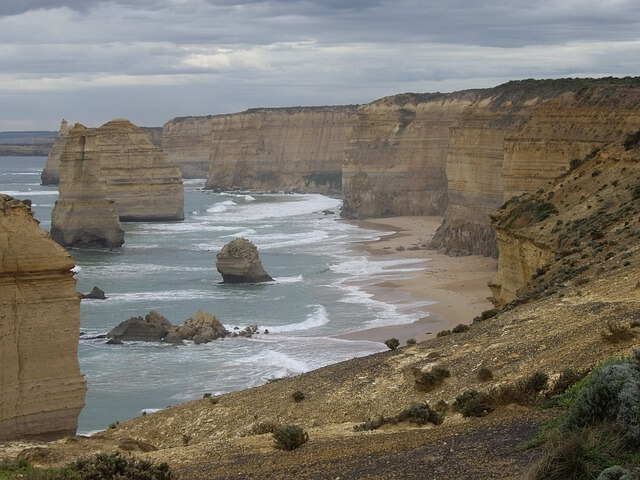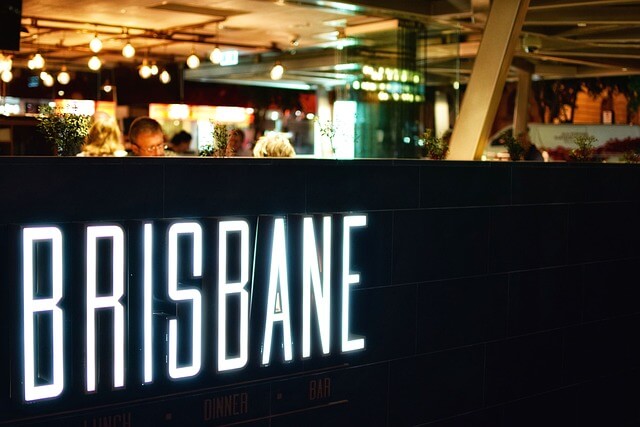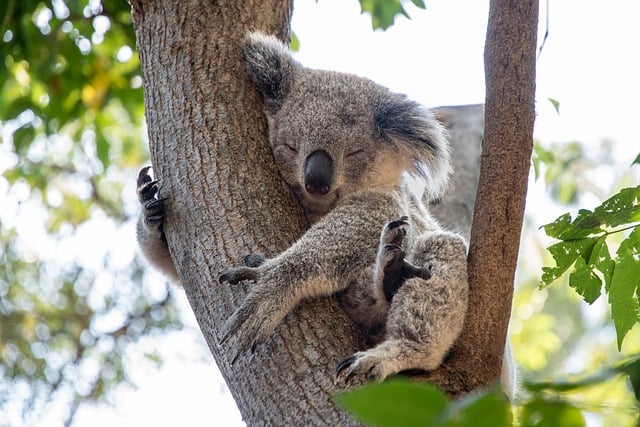Study Abroad in Australia: Immersion Intensifies the Experience
By Jennifer Fromal

|
|
The 12 Apostles near Melbourne, a natural wonder in spectacular Australia.
|
The 26-hour trip from the United States to Australia transcends time. It catapults you into another world of culture, landscape, and adventure. As you miss a day on the flight, advancing steadily through time zones, it starts to set in that you may also miss your family, friends, school, car, and other things that you associate with home. When you finally reach Australia, all those worries have melted into a sleepy numbness that leaves you engaged in the warmth of the blazing sun and warm smiles that welcome you to your new temporary home.
Inspiration
As a sophomore in college, I had always planned to study abroad in my junior year. I quickly set my sights on my school’s study abroad program at the University of Queensland in Brisbane. I imagined surfing at Bondi Beach in Sydney, camping outside in the Outback, and snorkeling in the Great Barrier Reef. Brisbane is literally on the opposite side of the world from my hometown, which made it more appealing. I was ready to venture out and experience anything Australia had to offer, culturally and physically. During my stay, I had the opportunity to explore Australia’s vast terrain while learning more about myself.
Preparation
When planning my 6-month study abroad trip, it was important to know where I would live, what the average temperature in Australia would be while there, how I would handle money, and what classes I would be taking for the semester. Program coordinators and mentors were available in America and Australia, making the guidance I received plentiful and helpful. In fact, my program advisor in Australia created a site for students traveling abroad in Australia that offers tips and advice. Additionally, she has published a book titled “Studying Abroad in Australia,” which serves as a pre-departure guide for students. Although I had not read any travel books before my trip, finding study-abroad experiences and testimonials from students on various websites was relatively easy as they were plentiful and enthusiastic.
I packed clothes for the appropriate summer season. I researched banks in Brisbane to open an account there and transfer money from my American bank account. This was the easiest way to deposit and withdraw money in Australia since I would be there for six months. I chose classes once I was enrolled via the University of Queensland’s registrar system. I used a campus map to see where my classes would be held. I felt fully prepared for my living and academic situations before arriving in Australia.
Adaptation
to Australian Life
Once abroad, the most difficult challenge involved setting aside the traditional notion of being a tourist and accepting that I had to fully immerse myself in Australia to gain the most from the trip. For the next six months, I was an Australian. It was vital to me to make friends with Australians quickly. I could do so because I lived in a college with 250 other students, some of whom were from Zimbabwe and South Africa, though the majority were Australian. I have learned that many study abroad programs place students in off-campus apartments with other American students, often from their home university. I find this counterintuitive to the mission of study abroad, which is to learn about native culture and build relationships in addition to attending classes. Luckily, my study abroad program allowed me to meet Australians on my first day in the country — some of whom remain my friends today.

|
|
Bars of all kinds are a big part of the nightlife scene in Brisbane.
|
Immersion in Daily Australian Life
The importance of meeting native Australians meant that I was accepted in social circles and invited to participate in team sports and clubs. My Australian friends were pleased to introduce me to the dynamic Brisbane nightlife. They offered me helpful tips about which tourist traps to avoid. I also went on two home visits with friends to meet their families and see the neighborhoods where they grew up. These personal glimpses into the lives of Australians were special to me. They provided time to talk intimately about cultural differences and Australians’ views of Americans. My Australian friends were also able to give me tips about public transit and the best vacation spots to visit.
Getting Around
Australia
One of the things I wish I had known more about before arriving in Australia is how the train and bus systems in major cities work. My American friends and I often found ourselves lost in the city, looking for a bus stop and walking without direction in search of a way home. However, once we learned the bus routes for our university stop, travel around Brisbane became much more manageable. Researching websites about bus fares, student discounts, and where to buy bus passes made public transportation more accessible to manage and less expensive than taking a taxi.
Exploring Australia
In addition to the trips my friends and I took to various beaches near Brisbane, the study abroad program also organized trips to show us other sides of Australia. We took a long weekend trip to Sydney, where a personal tour guide showed us around day and night. Often, on such trips, we would stay in hostels — the cheapest way to lodge in Australia. Like Europe, hostels are clean, inexpensive, and often plentiful and easy to find. The study abroad program also provided us with an Outback trip, during which we stayed on a 5,000-acre cattle farm with a family that lives and operates it. They allow visitors, provided they work on the farm during the day. During our week in the Outback, we learned how to feed the cattle, set out pumps for drinking water, chainsaw prickly pear trees, and tend the orphan calves. This experience is one I will never forget, and I feel lucky to have joined in.
For spring break vacation from school, some American friends and I went on a sailing trip to the Whitsunday Islands, which have beaches hailed by National Geographic as the most serene and precious in the world. We spent five days aboard a sailboat with 12 other travelers from around the world. Our daytime activities included sea kayaking, snorkeling, and visiting the islands.

|
|
A koala bear hugs a tree in a park near Brisbane.
|
Academic Immersion
At the university, I chose to take classes that would help me learn more about Australian culture, such as courses in Australian literature and Australian marine life. As an English major, I found the Australian literature course very interesting and informative. While early American literature courses consist of captivity narratives and stories told in the Puritan tradition, Australian literature focuses on the Aboriginals and the consequences of being a colonial nation.
The Australian marine life course offered students studying abroad in Australia the opportunity to learn about unique habitats, such as the Great Barrier Reef, the many rivers and estuaries, and the native animals that inhabit these places. Enrolling in a class like this was a precious tool that proved helpful when studying Australian wildlife. The class also took two field trips accompanied by the professor and teaching assistants to explore the coast of Australia and conduct our own marine research projects. The two field trips were to Heron Island and Stradbroke Island, both of which offered chances to see what, for me, were exotic animals, to experience tide changes, and to see coral reef formations.
Lessons Learned
in Australia
Planning a study abroad trip is essential to ensure you will experience some of the many facets of life in a new place. In addition to securing information on living arrangements and financial needs, it is important to learn what the food will be like and how to get around your new location.
However, some things cannot be planned and will only reveal themselves once you are abroad. Making friends quickly and being willing to adapt and explore new situations is a must for anyone studying abroad. While a 6-month or 1-year trip seems like a long time, it passes very quickly once immersed in a new culture and a new way of living.
Since returning from Australia, my interest in traveling and experiencing new cultures has been stimulated. Instead of regretting that I did not visit places like Thailand while I was abroad, I look forward to traveling to the Pacific region again. I also returned with a calmer nature and a more optimistic outlook on life, which I believe I picked up from my Australian friends. Their motto of “no worries” rings true in terms of how they live their lives and enjoy each and every day. Australia is a country of thriving cities, such as Melbourne, Brisbane, and Sydney.
Nevertheless, a laid-back attitude pervades everyday activities. I often reflect on my study abroad trip to Australia and tell stories to my friends whenever I can. Studying abroad and immersing myself in Australian life have made me a better-rounded person with broader cultural experience, which has contributed to a better understanding of my limits and abilities.
For More Info on Australia
The University of Queensland partnered with Dickinson College, so this was my home university's only study-abroad option in Australia. Other American universities have partnerships with Australian universities, such as Griffith University, the University of New South Wales, and the University of Sydney.
Cromwell College: In Australia, the term “college” refers to a collection of dormitories for students near the university.
Semesterinaustralia.com: A site designed to help students find accommodations for students to live while studying abroad in Australia.
Visit Brisbane: Brisbane is the third-most populous city in Australia and offers many diverse activities, such as museums, wildlife sanctuaries, beaches, and sporting events.
|
Jennier Fromal’s hometown is Lancaster, Pennsylvania and she is currently a senior English major at Drexel University.
|
